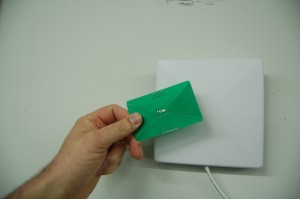 (Morrisville, N.C.) Collaborative product design and development firm Montie Design is now actively selling its innovative radio frequency identification (RFID) detector card to domestic and international clients. Small enough to fit into a shirt pocket or clip to an ID badge, Montie Design’s product enables users and installers to detect whether an RFID reader is actually sending out a signal.
(Morrisville, N.C.) Collaborative product design and development firm Montie Design is now actively selling its innovative radio frequency identification (RFID) detector card to domestic and international clients. Small enough to fit into a shirt pocket or clip to an ID badge, Montie Design’s product enables users and installers to detect whether an RFID reader is actually sending out a signal.
“We have sold cards in six foreign countries and have interest from distributors in Japan and Sweden,” said Karl Frank, Montie Design’s Business Development Manager. The $20 cards were released for purchase just two months ago. “We have also sold cards to the U.S. Department of Homeland Security and users of every kind from research labs to system integrators across the United States,” Frank added.
Manufacturers and retailers utilize RFID tags heavily in supply chain management for identification and tracking purposes to improve efficiency and save costs. They are growing in popularity as replacements for barcode tags due to their ability to be read at a distance without contact. Every RFID tag attached to a product contains an integrated circuit and antenna, and is dependent upon the functionality of a corresponding RFID reader to effectively read and record the information encoded on the tag.
According to Montie Roland, his company’s product – assembled by GRT Electronics in Raleigh, N.C. – helps determine if an RFID reader might have suffered a hardware failure, a triggering sensor may not be working, or communications with a back-end system may have been interrupted.
“The first question during setup or troubleshooting of an RFID system is whether the system is radiating a signal from the reader’s antenna,” he said.
Installers or users need simply move the RFID detector card towards the RFID reader antenna; if the RFID reader antenna is actively radiating a signal, the center of the card will activate a bright blue led light. Depending on the antenna and the power level radiated by the RFID system, the card will illuminate as far as two feet away from the antenna.
The Montie Design card works with European and Japanese RFID frequencies as well.
To learn more, or purchase a card, visit www.montie.com.
About Montie Design
Montie Design is a collaborative product design and development firm with core competencies in industrial design, mechanical design and fuzzy front end services. Implementing a client-centric approach in taking products from concept to marketplace, Montie Design balances vision with usability in realizing products that are economical to manufacture, elegant and robust. The firm operates out of the Research Triangle Park region of North Carolina with access to industry-leading technology, resources and innovative thought. For more information, visit www.montie.com.
Media Contact:
Montie Roland
montie@montie.com
800-722-7987
919-412-0559


